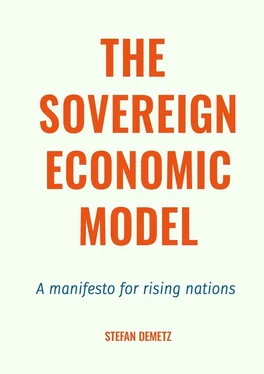Stefan Demetz - The Sovereign Economic Model. A manifesto for rising nations
Здесь есть возможность читать онлайн «Stefan Demetz - The Sovereign Economic Model. A manifesto for rising nations» — ознакомительный отрывок электронной книги совершенно бесплатно, а после прочтения отрывка купить полную версию. В некоторых случаях можно слушать аудио, скачать через торрент в формате fb2 и присутствует краткое содержание. ISBN: , Жанр: popular_business, на английском языке. Описание произведения, (предисловие) а так же отзывы посетителей доступны на портале библиотеки ЛибКат.
- Название:The Sovereign Economic Model. A manifesto for rising nations
- Автор:
- Жанр:
- Год:неизвестен
- ISBN:9785005666475
- Рейтинг книги:4 / 5. Голосов: 1
-
Избранное:Добавить в избранное
- Отзывы:
-
Ваша оценка:
- 80
- 1
- 2
- 3
- 4
- 5
The Sovereign Economic Model. A manifesto for rising nations: краткое содержание, описание и аннотация
Предлагаем к чтению аннотацию, описание, краткое содержание или предисловие (зависит от того, что написал сам автор книги «The Sovereign Economic Model. A manifesto for rising nations»). Если вы не нашли необходимую информацию о книге — напишите в комментариях, мы постараемся отыскать её.
The Sovereign Economic Model. A manifesto for rising nations — читать онлайн ознакомительный отрывок
Ниже представлен текст книги, разбитый по страницам. Система сохранения места последней прочитанной страницы, позволяет с удобством читать онлайн бесплатно книгу «The Sovereign Economic Model. A manifesto for rising nations», без необходимости каждый раз заново искать на чём Вы остановились. Поставьте закладку, и сможете в любой момент перейти на страницу, на которой закончили чтение.
Интервал:
Закладка:
Despite its supposed similarity to communism, all countries practice some form of state capitalism, or economic interventionism. Some openly admit and carry it as part of a national economic model. Such countries might be from the former Soviet or communist bloc, or countries formerly associated with the USSR. Some less advanced countries also favor employment over other economic factors. Self-declared liberal countries apply ad hoc economic interventions for corporations «too big to fail» or «too important to fail,» or they apply corporate welfare to please extremely powerful lobbies, which results in various forms of economic distortion. Here the state uses subsidies, regulations, and price controls to help national companies, erect non-tariff hurdles to ward off foreign competition, and fix prices to protect an industry or wages (minimum wage) that secure some social stability. Tax credits, tax incentives, and tax exemptions are used to support business sectors or regional areas or to help establish new industries. For example, in the green energy business, less environmentally friendly fuels and fossil fuels are penalized. Regulations can elevate local standards in ways that leave foreign companies struggling to keep up or require huge expenses to realign. Others, especially those with wealth created by natural resources like oil, gas, and mining, have created sovereign wealth funds to hoard profits from the extraction industries.
Another good reason for state capitalism is that the government can act similar to the spring in a car’s shock absorber and like a rudder on the economy to absorb economic shocks and volatility and to steer some business practices. For example, a government can require the use of certain national technologies to improve the economy instead of letting companies choose. This might not be efficient in the short term, and it may cost some private companies’ profits, but it can be a winning strategy in the long term because such policies ultimately build up domestic industries. It is a trick to effectively make some industries subsidize others.
Is state capitalism too top-down? One mistake of communism is its desire to control all business activity, down to individual small businesses. State capitalism instead wants to control the major strategic sectors of the economy and regulate some others. Instead, in non-strategic sectors, such as light industry and services, the sovereign state should make rules that foster innovation and competition. This can be accomplished through low taxes and regulations, strong competition, and antitrust law. Other measures, too, are implemented to allow business to flourish without interference.
Capital, the Real Economy, and Wealth Creation in State Capitalism
Capital is a required element for wealth creation. State capitalism, by ownership and control of strategic industries, makes sure that capital, as profits, gets reinvested in industries that create wealth. State capitalism effectively monopolizes rent-seeking industries and market sectors, which produce most capital in the form of profits and dividends. A state can use that profit to reinvest in the real economy’s industries and reduce non-working capital in the economy.
Through such investment, state capitalism can be an effective strategy for economic development. One shortfall of liberal capitalism is that it is not aligned with the needs and strategic direction of a country: private businesses just chase profit or money accumulation. Usually in liberal capitalism, this is obviated by legislation and taxation to encourage private businesses to invest and enter a specific market segment. This investment is rarely encouraged to effectively meet a need, but more for declaring success by showing off highly questionable GDP numbers. In capitalism, money, like water, flows where there is less resistance and gives higher returns. So investors prefer to invest in fast food or coffee chains instead of in big industrial enterprises, which come with higher risk, longer production times, and fewer returns. Money, like water, can flow where it is unnecessary, where it does not bring benefits to the country, its people, and the wider local community. More refined forms of state capitalism as practiced in the Sovereign Economic Model are comparable to the management of water resources, such as riverbeds, basins, and coasts. Water, like money, must be directed in ways that create not disasters, but benefits to the local community.
State Capitalism 3.0 is the latest upgrade and current version. At the present moment, it is viewed as the third version after two iterations in the 19th and the 20th centuries. Currently, it is practiced to meet the following goals:
• Protect the financial markets from globalization and foreign ownership.
• Create a central bank to protect the national banking institutions.
• Progress development to the level of the most advanced countries.
• Establish a hybrid state capital.
• Promote state-led capital accumulation.
Several types of state capitalism exist. It has many forms, depending on the country and mindset:
• Some are derived from geopolitical issues, with sanctions and trade wars pushing a country to adopt passive or active forms to fight off foreign countries and their companies.
• Ideological state capitalism is more inclined to stabilization and socially relevant topics like protection of society from financialization and globalization.
• Protectionist state capitalism is more preoccupied with defending the market from foreign invasion.
• Competitive state capitalism uses this form to compete, often unfairly, with other countries.
No prescribed model of state capitalism exists and there is no formula to define which is best or even what works. The best model to use is tailor-made for the country and brings the greatest benefits to its economy.
State-Owned Enterprises as Representatives of State Capitalism
Many liberal countries, despite their self-acclaimed free markets and capitalism, own several state-owned enterprises (SOEs). Examples are Amtrak rail network in the US, banks in the UK, the alcohol monopoly in Sweden, and utilities in many countries. Germany even has a state-owned beer brewery. Further, many SOEs are owned by regional or local governments and municipalities.
SOEs can have many modus operandi, depending on their political context. The tactics used, even on the internal market, may be passive and defensive or offensive and aggressive. In the first case, SOEs compete for the market share fairly, collaborating even with private businesses. In the second case, they compete aggressively and use government political power to introduce laws that benefit them, gain monopolistic positions, and push private business out of the market.
Management and governance of SOEs is a sore point. In some oil and gas exporting countries, large SOEs are mainly concerned with managing the enormous wealth of this market sector. Most are run decently or well as they are critical to state budgets. In many other fields, SOEs were, and are, badly managed. Mainly they are subjected to political tussles, run by politically appointed leaders, and used as overweight cash cows until the business environment, through heightened competition or technological changes, reduces them to a burdensome money-losing enterprise that gets privatized quickly. Relevant examples are the post offices of various countries, which have been privatized or floated on stock markets, or have suffered gargantuan losses. For instance, consider the US Postal Service (USPS), which is technically not an SOE but a special government agency, and Amtrak, the US railway operator. In monocratic government systems in Asia, SOEs fare relatively well as the governments set strict rules that administrators must follow. Deviations or political fiefdom (corruption) are harshly punished, up to death sentence. Putin’s Russia has perhaps struck the perfect «golden middle.» Many of Russia’s large SOEs, such as Gazprom (gas), RosNeft (oil), and Sberbank (banking) are traded on the stock market; the state owns slightly over 50 percent, and the rest belongs to private and minority shareholders. Therefore, the state has achieved several goals: absolute control and money along with liquidity and partial privatization. The boards and management of these companies are stuffed with foreign executives. In this way, local politicians cannot defy the shareholders’ governance and run their fiefdoms, as would be expected to happen with only local governance.
Читать дальшеИнтервал:
Закладка:
Похожие книги на «The Sovereign Economic Model. A manifesto for rising nations»
Представляем Вашему вниманию похожие книги на «The Sovereign Economic Model. A manifesto for rising nations» списком для выбора. Мы отобрали схожую по названию и смыслу литературу в надежде предоставить читателям больше вариантов отыскать новые, интересные, ещё непрочитанные произведения.
Обсуждение, отзывы о книге «The Sovereign Economic Model. A manifesto for rising nations» и просто собственные мнения читателей. Оставьте ваши комментарии, напишите, что Вы думаете о произведении, его смысле или главных героях. Укажите что конкретно понравилось, а что нет, и почему Вы так считаете.












